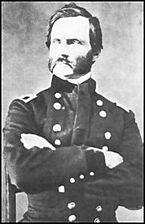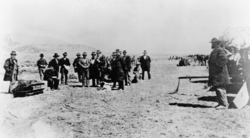Investigations and prosecutions relating to the Mountain Meadows Massacre facts for kids
The Mountain Meadows massacre was a terrible event that happened on September 11, 1857. Many people traveling through Utah were killed. Finding out who was responsible for this crime took a long time, especially because the American Civil War started soon after.
Contents
Brigham Young's Role
Historians still discuss how much Brigham Young, a leader of the Latter-day Saints (LDS) church, was involved in the Mountain Meadows massacre. They debate if he ordered the attack or if local church leaders in Cedar City acted on their own. Young used strong words against the US Army, which created a tense atmosphere. After the massacre, Young publicly said that God had punished the travelers. It's not clear if he believed these travelers were a real threat or had harmed Mormons in the past.
Young's Message Arrives Too Late
On September 8, 1857, a US Army officer named Captain Stewart Van Vliet came to Salt Lake City. He wanted to tell Brigham Young that the army was not coming to attack the Mormons. Instead, they wanted to set up a base near Salt Lake City and buy supplies. Young was suspicious and said the Mormons would fight back.
On September 10, 1857, a messenger named James Holt Haslam arrived in Salt Lake City. He had traveled nearly 300 miles to deliver a letter from Isaac C. Haight, a local militia leader. The letter from Haight has never been found.
Young sent a reply to Haight on September 10. His message said: "You must not meddle with them. The Indians we expect will do as they please but you should try and preserve good feelings with them. There are no other trains going south that I know of[.] [I]f those who are there will leave let them go in peace."
However, by the time Young's message reached Haight, the massacre had already happened. According to Haslam, when Haight read the letter, he cried and said, "Too late, too late." Historians still discuss what Young's letter truly meant. Some believe it shows Young did not want the massacre to happen. Others think the letter might have had a hidden meaning.
Paiute People's Involvement
A few weeks after the massacre, on September 29, 1857, John D. Lee met with Brigham Young. Lee told Young that over 150 "mob members" had insulted the Saints and poisoned a beef given to Native Americans, as well as a spring. Lee claimed this made the Native Americans angry, and they attacked, killing everyone except eight to ten children. He also said the Mormons saved another group of travelers. Wilford Woodruff wrote that Lee's story was a "tale of blood."
In reality, seventeen children survived the massacre. Their names and ages are known. The Mormons sold these children to different families and kept the stolen goods from the travelers. John D. Lee, Haight, and Philip Smith went to Salt Lake City to ask Young what to do with the property. Young refused the money they offered. He told Lee to give the cattle to the poor. Lee ended up with a fancy carriage from the travelers. Other items like wagons and rifles also ended up with Mormons. The Paiute people later pointed out that this showed they did not commit the massacre.
On September 30, 1857, Mormon Indian Agent George W. Armstrong also sent a letter to Young. He claimed the travelers had poisoned beef, causing many Native Americans to die. He said the Native Americans then killed 57 men and 9 women, with no mention of survivors.
Years later, Brigham Young's son, who was 13 in 1857, said he was in the office when Lee met Young. He remembered Lee blaming the massacre on the Native Americans. Paiute leaders today say that Mormon stories about them starting the attack are not true. They point out that Paiutes had no history of attacking wagon trains. No Native Americans were ever charged or punished by federal officials for the massacre. Oral stories from Paiute people in the 1980s and 1990s say they watched the attack from a distance and did not participate. Some stories say a few Paiutes were present but did not join the killings.
One oral history from Sybil Mariah Frink tells of seeing the massacre being planned at her home. She said she followed fourteen Mormons who had dressed up as Native Americans to the massacre site. She did not mention any Native Americans taking part in the attack.
While some Paiute people were likely present during the first attack, reports about their exact numbers and involvement are different. However, Mormon eyewitness accounts are not always reliable, as they tried to shift the blame to the Native Americans.
Eyewitness accounts from Mormons that blame the Paiutes are different from Paiute accounts that say they did not participate in the actual killings. Historian Bagley notes that it's hard to tell the full story because the sources are confusing. However, an investigator named Carleton mentioned in 1857 that even Jacob Hamblin, an Indian agent who blamed the Paiutes, admitted that the Paiute tribe only had three guns in 1856. This suggests it would have been very difficult for them to cause so many gunshot wounds, as most victims were killed by gunfire, not by stones as some Mormons claimed.
Militia's Role in the Massacre
Even though militia members tried to blame the Native Americans, many non-Mormons suspected Mormons were involved and asked for a federal investigation. Garland Hurt, a US Indian Agent, sent a translator to investigate after the massacre. The translator reported that Paiutes attacked the travelers, but after three attempts, Mormons tricked the travelers into surrendering and then killed them all.
On his way to Salt Lake City to report the massacre, John D. Lee met Jacob Hamblin. According to Hamblin, Lee admitted to killing travelers, including young children, and said he was following orders from leaders in Cedar City. Lee later denied saying this or breaking his promise of secrecy.
Brigham Young first heard about the massacre from others. After Lee reached Salt Lake City, he met Young on September 29, 1857. Lee claimed he told Young about Mormon involvement. However, Young later said he stopped Lee from giving details because he couldn't bear to hear them. Despite this, Jacob Hamblin said he heard a detailed description of the massacre and Mormon involvement from Lee and reported it to Young and George A. Smith soon after. Hamblin said he was told to keep quiet but that "as soon as we can get a court of justice, we will ferret this thing out."
Federal Investigations in 1859
The Utah War stopped federal investigations for a while. Then, in 1859, two years after the massacre, investigations were done by Jacob Forney, who was Hurt's boss, and by US Army Major James Henry Carleton.
Carleton's report in May 1859 included statements from Jacob Hamblin and a young Snake man named Albert Hamblin. Both tried to blame the local Paiute people. But Carleton found contradictions in their stories, suggesting they were not entirely true. Carleton tricked Albert Hamblin into naming some of the Mormons who were there. Albert then admitted that John D. Lee, Prime Coleman, Amos Thornton, Richard Robinson, and "Brother" Dickinson were present.
Carleton also spoke to Paiute chiefs. Chief "Jackson" said that a letter from Brigham Young had ordered the travelers to be killed. He claimed 60 Mormons, painted and disguised as Native Americans, led by Bishop John D. Lee and Isaac C. Haight, carried out this order. Another Paiute chief, Touche, said a young man named Oliver B. Huntington brought a similar letter from Brigham Young to his group.
By August 1859, Jacob Forney, the Superintendent of Indian Affairs for Utah, had collected the surviving children from the Mormon families who were keeping them. He prepared to send them back to their relatives in Arkansas. Forney and Captain Reuben Campbell of the US Army said that Lee had sold the children to Mormon families. Sarah Francis Baker, who was three years old at the time, later said, "They sold us from one family to another." Forney reported that none of the children had ever lived with Native Americans. He refused to pay families who claimed they bought the children from Native Americans, saying he knew it wasn't true. Families did receive some money for caring for the children, but some complained it wasn't enough.
Forney concluded that the Paiutes did not act alone and that the massacre would not have happened without the white settlers. Carleton's report to the US Congress called the killings a "heinous crime" and blamed both local and senior church leaders.
A federal judge named John Cradlebaugh held a grand jury in Provo in March 1859 to look into the massacre. However, the jury did not bring any charges.
Trials of John D. Lee
| Four of the nine Utah Territorial militiamen who were charged in 1874 (Not shown: William H. Dame • William C. Stewart • Ellott Willden • Samuel Jukes • George Adair, Jr.) |
|||
|---|---|---|---|
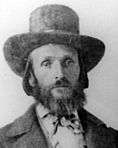 |
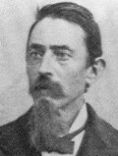 |
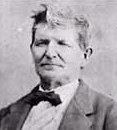 |
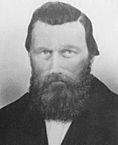 |
| Isaac C. Haight was a Southern Utah Church Leader and militia commander. He spent much of his life hiding and died in 1886 in Arizona. | Maj. John H. Higbee was said to have given the order to start the killings. | Maj. John D. Lee was a local official and Indian Agent. He led the initial attack and falsely promised the travelers safety. He was the only person found guilty. | Philip Klingensmith was a church leader and militia member. He took part in the killings and later agreed to testify against others after leaving the church. |
Investigations continued in 1871 when prosecutors got a statement from militia member Phillip Klingensmith. Klingensmith had been a church leader and blacksmith. By the 1870s, he had left the church and moved to Nevada.
During the 1870s, Lee, Dame, Philip Klingensmith, and two others were charged and arrested. Warrants were issued for four others who had gone into hiding. Klingensmith avoided being charged by agreeing to testify. Brigham Young removed some participants, including Haight and Lee, from the LDS church in 1870. The US government offered rewards for the capture of Haight, Higbee, and Stewart.
Lee's first trial began on July 23, 1875. The jury had eight Mormons and four non-Mormons. The trial ended with no decision on August 5, 1875.
Lee's second trial started on September 13, 1876, with an all-Mormon jury. This time, Lee was found guilty.
In 1877, John D. Lee was executed by firing squad at Mountain Meadows. He had chosen to be shot. Lee himself said he was being blamed for others involved in the massacre.



